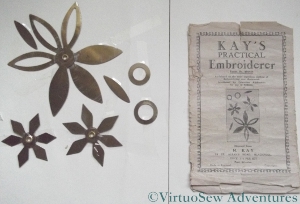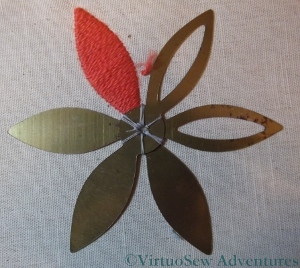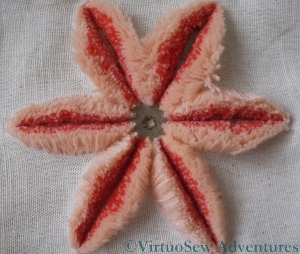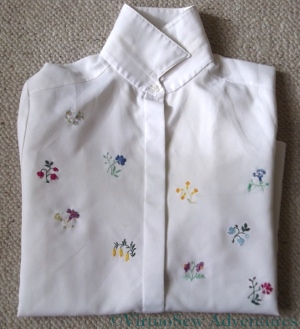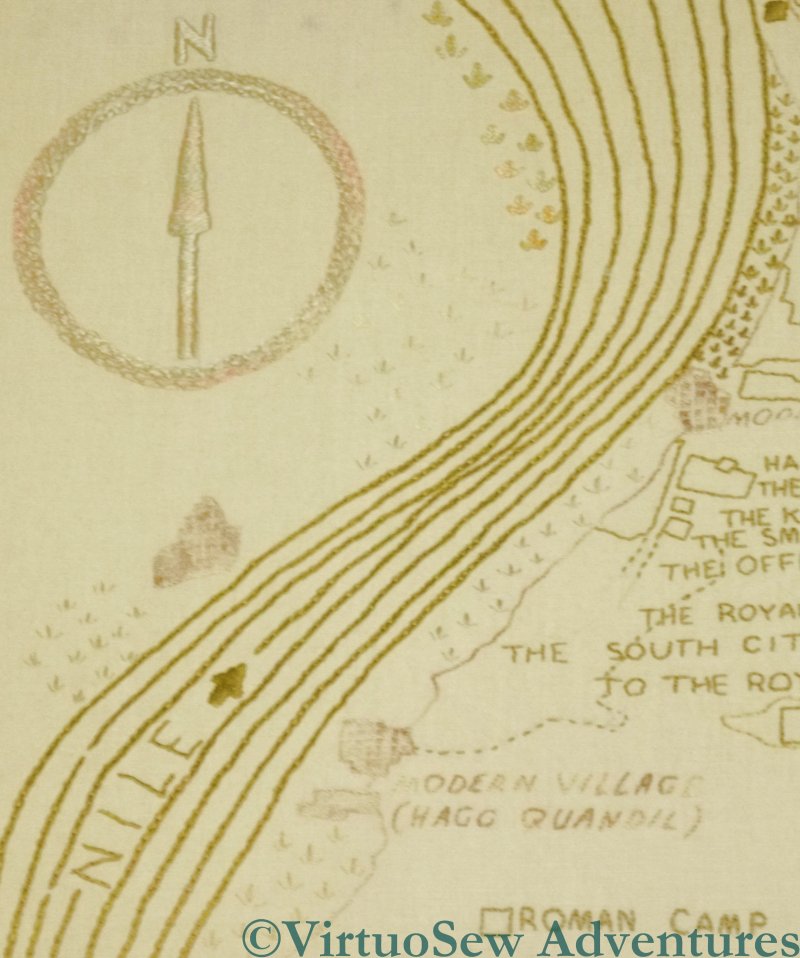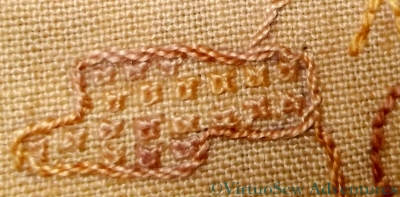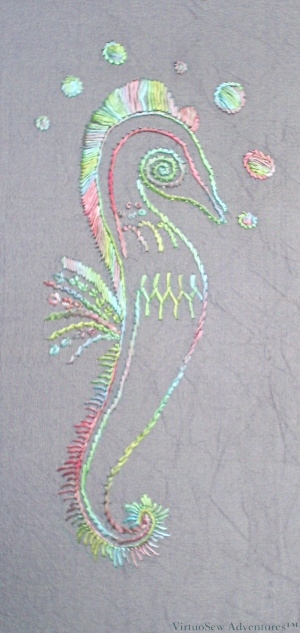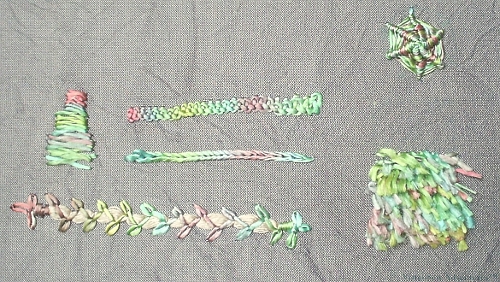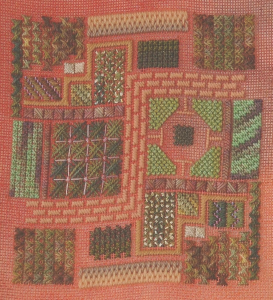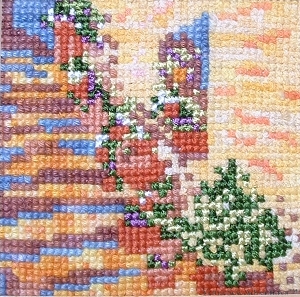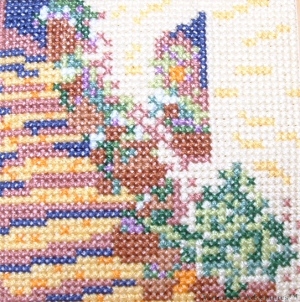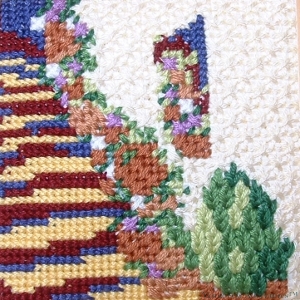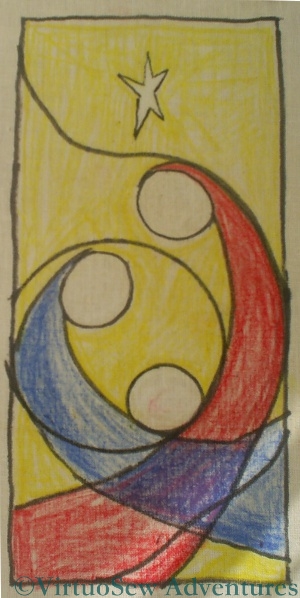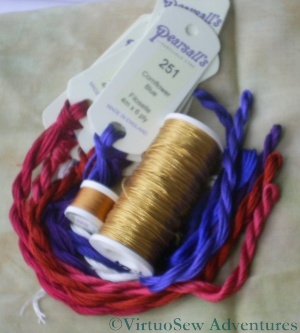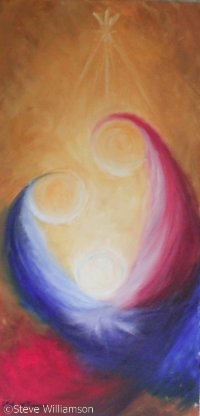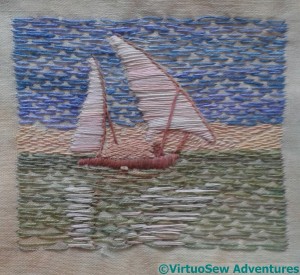Tag: experiments
Experiments in Woolwork
EBay is a very dangerous place…
I bought several more copies of The Needlewoman magazine on eBay when I first discovered it (eBay, that is!), and some of those magazines mentioned “a new style of embroidery” using metal templates. It was called Kay’s Practical Embroiderer. Some time later, a set of the templates came up for sale. Furthermore, I won the auction, so I can now experiment!
The templates are mentioned in passing in the book Stitching For Victory (mentioned in my post about the teacloth that took three generations to complete), as a quick and easy method to create stylish embellishments using what was most readily available – darning wool.
Of course, darning wool is almost impossible to find nowadays, but I have plenty of Paterna Persian yarn, so I am using that for this first experiment. It’s much fluffier and more springy than darning wool, so it won’t be exactly like the original, but I’m hoping it will give me some more ideas. It’s certainly making a huge change from the fine work I’ve been doing on the Spot Sampler!
So here is the beginning of my experiment. The idea is that there are several layers of surface satin stitch worked over the metal template. I have to say that I would tend to quarrel with the idea of this being a quick technique. As I made progress and added each of the layers on to the petals, it became more and more difficult to to make the stitches. In fact, I made copious use of a needlgrabber (which did help, very much indeed), and frequently broke the thread. I wonder whether that might have been partly because darning wool would have been stronger and more tightly spun than the Persian yarn, and also, perhaps, because the darning wool would have been finer. The instructions say to use two strands of wool in each layer, and I’ve done so. I’m still wondering whether that was right, although I am rather afraid that if I were to use a single strand it might look a bit half-hearted.
Once the stitching is complete, you snip down the centreline of the shape (not easy, even with my very special sharp embroidery scissors), and end up with a raised, furry shape. Finish it off with a few lines of ordinary stitching, and you have a very textured, striking piece of work. The leaflet has a selection of suggested designs and ideas, and it will be interesting to see whether I can manage to devise ways to use the ideas in new ways.
A flowered blouse
As Spring shows her head after the chill of Winter, I am beginning to fish out clothes other than bulky winter woollies. This is a simple polyester blouse I embroidered some years ago when I had time, an itch to embroider, but absolutely no money to buy fabric.
I used a Free Transfer from The Needlewoman of January 1934 (from the boxful that Grandmama gave me), showing sprigs of flowers which they suggested might be used for lavender bags, traycloths, handkerchiefs, or underwear (if only I had the time and skill to make lovely silk embroidered undies!). The silk threads came from my stash (even fifteen years ago my stash was extensive and varied!), and in fact I think the whole idea of the project was that I wanted to use those threads in particular.
I’m not really a “floral”-type person, or at least the florals I stitch tend to be quite heavily stylised, and I’m also not someone who likes perfect symmetry. So I snipped out some elements from the transfer and arranged them irregularly on the front of the blouse. Once they were transferred, I arranged the threads, so each colour appears on each side of the button placket, but not on the same flower sprig.
I will provide close ups in another post, when I have worked out how to format them!
Dreams of Amarna – The Patches on The Map
After finishing the text and the villages on the Map, I need to decide what to use for the cultivation… You may recall from my earlier post that I have decided on the stitch I’m going to use – tête de boeuf stitch – but that I’ve not quite worked out what thread to use.
I’ve stitched a variety of trial patches, using stranded cotton, flower thread, pearl cotton, and several different silks, and now all (all!) I have to do is make a decision. I’ve propped up the fabric in the living room and stand staring at it every chance I get!
So far, I feel sure I won’t be using the pearl cotton (too chunky) or the flower thread (also too chunky), but that leaves me two variegated silks (one pale green shading to pinkish purple and one brighter green shading to terracotta) and two plain silks (one slightly darker than the colour of the fabric, and one the same colour as the stranded cottons I used for the contour lines. I’ve tried very hard to get a photo that does reasonable justice to the various threads and colours, but I don’t think that the one I’ve got here helps very much…
I chose Sorbello stitches to represent the modern villages. These are worked at a very small scale, as you can see from the thread count. Again, had I followed the cartographer’s symbols, I would have used something like Jacobean Couching, but I felt that this stitch in fact reflects the idea of buildings rather better. I’ve used the same gold-shading-to-purple thread for all the modern villages, both the names and the associated areas. It doesn’t draw the eye, in real life, quite as much as you might expect.
An Experimental Seahorse
Sometimes I play with threads for no other reason than to play with them. In this case Stef Francis gave me a skein of overdyed filament silk to play with. She tends to create a much more “freeform” style of embroidery than I do and she wanted to know what I thought of the thread.
I found a simple transfer that offered scope for several different stitches, and started playing. I had been concerned that it might twist up when I didn’t want it to, but it stayed fairly flat most of the time, and it is noticeable that the stitches look and feel different in a flat thread, as compared with a round one.
For example, in a round thread, the stem stitch line tends to be more textured, and the direction of slant is more obvious. Here, the slight flatness creates a smoother line. That same flatness makes the satin stitch smoother and cleaner looking. It also helps to mask any slight imperfections in the stitching!
On the other hand, that same slight “spread” of the filaments clouds the distinctiveness of the Wheatear Stitch in the fin on his back, so not an unalloyed success, but interesting and worth trying all the same.
Then I started just to play with stitches in a spare corner of fabric. The Braid Stitch (top row) works quite nicely, I think, and the Turkey work (bottom right hand corner) is better than I hoped, especially considering that I’ve not done it before. I can’t imagine what I would use that texture for in these colours, but Stef has a fabulous range of overdyed shades and I am sure that something would spring to mind for one of them. The little triangle of Closed Herringbone Stitch is hardly a success, but that may be a problem of scale. I don’t think the Braid Stitch would have worked if it had been any wider than it is here.
I don’t think this thread adds anything to the Reverse Chain Stitch, or to the Spider’s Web Wheel, but I do like the Chained Feather Stitch couching. In fact, that might have been better had I had the courage of my convictions and made the base that’s being couched about twice the width.
All in all, I had a lot of fun playing with this thread. I’ve now got a much better idea of What To Do and more importantly What Not To Do with it. One important thing to remember – make sure hands are smooth! Silk catches on everything and filament silk does so even more!
The Canvaswork Abstract Garden
Following on from the Knot Garden, I decided to play a little more with the idea of using the canvas as a background, rather than covering it entirely. Since I already knew the canvas would not be covered, I chose a piece of dyed canvas (from “Kate’s Kloths”, which I haven’t been able to find online).
The first element was the simple path in expanded brick stitch, worked in wool. The rest of the panel was then built up as a pattern of varying stitches and threads. There was no predetermined idea, simply the aim of keeping a sense of balance and rhythm in the pattern densities. You will notice that block sizes and shapes are repeated, reflected across the path which snakes across the centre.
I’m not particularly comfortable with abstract work or even with designing it, so this repetition and reflection of the blocks was a way to give myself a structure for the piece. Otherwise I find abstract work often feels rather chaotic and it doesn’t offer me the chance to puzzle out “a good stitch to represent such-and-such”, which is where a lot of the fun of the Persian Fantasy came from.
This was an interesting exercise, but like the Knot Garden, it has remained as a piece of canvas, not mounted, framed or incorporated into anything, because I really haven’t a clue what to do with it!
Steps in the Sun
Some years ago, I was asked by a magazine to design “my interpretation of buildings” in counted work. I produced three versions of the same thing – a set of steps in a Tuscan village, with plants in pots on the steps and a window looking over them. Then the magazine didn’t use them. Any of them. Sigh.
Never mind, I enjoyed doing them, and it was a very interesting exercise.
The colours are inspired by Monet’s Rouen Cathedral series – strong, bright colours with purples and blues as the shadows. They are like impressionist oil paintings in another way, too – it’s not always entirely clear quite what the shapes are until you have looked for a while.
For Version One I used counted cross stitch in space dyed and other threads. The walls were worked using a cotton bouclé, and the steps in a range of soft unmercerised cottons. The terracotta plant pots were worked in stranded cottons (solid colour), and the plants themselves were worked in rayon, also in solid colours. The threads were rather heavier than stranded cottons, so I used 22 count linen and stitched over two threads. The bouclé battled every stitch of the way!
For Version Two I used plain counted cross stitch in stranded cotton, chosen to reflect the colours of the overdyed cotton as well as I could manage. It is strange to see that the photograph gives the impression of the aida fabric showing through, which isn’t so obvious to the naked eye. This version actually is more successful in some ways than the first one, although I have them all three on the wall and I actually prefer Version One! Version Two is not so hectic, but still, it doesn’t “read” as clearly as I might like. Or at least, not to everyone. I see the steps in all three, but I know people who don’t.
In Version Three I became even more experimental – I knew the magazine wouldn’t go for this one, but thought it would make an intriguing exercise. The base fabric is ordinary aida, but I chose to use canvaswork stitches in stranded cotton. The bush in the bottom planter is worked in Leaf Stitch – oh, look, Leaf Stitch again! – and the steps are long-legged cross stitch. The wall is Double Straight Cross Stitch. I enjoyed this one the most, but at the scale of the piece (it is less than four inches square) there really is not enough space for most of the stitches to do their work properly.
An interesting exercise, all the same..
Christus Natus Est – Second Stage
The first step is to simplify the design, so that it becomes an embroidery design rather than a painting. I’ve transferred the simplified design using fabric crayons, and used a fabric pen to outline the sections. The design is about three inches by eight, which seems very large now I look at it, but I felt that if I tried to work it too small I risked multiplying the difficulties already inherent in learning a new technique.
The additional lines are contours for the gold threads, which I am going to couch down following the technique described in All that Glitters, by Alison Cole.
Thanks to some help and advice from Golden Hinde I’ve got the right sort of gold thread – an entire spool of it! I just hope one spool is enough…
I’ve decided to use Pearsall’s Filoselle Silk. As I am not sure how much of the gold will be covered by silk, I’ve only purchased one skein of each colour.
Regular readers will have gathered by now that there is a lot of guesswork involved in my embroidery! I suspect that changes between dyelots won’t matter too much when I am after an impression of rich and changeable colour.
Christus Natus Est – Introduction
A couple of years ago, my mother painted an absolute cracker of a painting – a semi abstract Nativity, which she entitled Christus Natus Est (Christ in Born). At the time it occurred to me that it might make a good design for an embroidery, and now I have decided on the style I am going to use – or nué.
Obviously I am going to change it somewhat, since the techniques of embroidery and oil painting are so different. For one thing, the background of closely spaced gold threads will be striking, effective, and rather reminiscent of an icon. So rather than covering the gold with coloured silk, the background will be left clear. Also, I don’t think I can hope to create the same subtlety of colour in the figures, so I will use only two or three shades of each colour.
Classic or nué uses straight rows of gold, but in her book All That Glitters, Alison Cole suggests spiralling and curving lines, so I am going to try that.
The first stage is to work out precisely how I am going to simplify the design and transfer that to the backing fabric. As none of it will be seen, I can simply use calico, and colour it with fabric paints.
Then I have to plan the placement of the spiral and curving lines. The obvious thing to do is to centre the circle on the Christ-child, but I think that is too obvious and will make a rather stiff design. Instead I will use a larger circle, centred between the Child and His Mother.
The original painting was one metre by one and a half, and clearly I won’t be embroidering it that big – it is going to be more like three inches by eight!
The Felucca Is Finished
I have finished the first trial of the Felucca design. As I always say of these design fragments, I do not yet know whether they will make it to the final piece.
You can barely see the stitching on the coastline – I used a fine thread and spaced the stitches far apart. For the cargo, I crammed the stitches as close to one another as I could. The sails are worked in Satin Stitches rather than darning, and the spars in Stem Stitches. I’ve decided I am happy with the pinkish tinge on the sails, and the greenish Nile is just as I imagined it would be.
I think it has worked. The reflections of the sails bring the whole piece to life, and I added some small stitches to provide an impression of a reflection of the spars.
Beginning the Felucca
I’ve begun to work on the Felucca design I have already described. As I am not at all sure about the colours or the stitching that I will want on the final panels (remember this is to be a design element for the edging panels I described a little while ago), or even the scale, I am thinking of working this design several times on different fabrics, with different threads and at different scales, to see which one I like best. I’m sure I will find something to do with any leftover pieces of embroidery!
This version is about two and a half inches by one and a half inches, and it is worked on turban cotton, just like the fabric I used for my earlier experiment with the Dig House. I’m using similar stiff overdyed linen threads as well, but this time I have learnt from the trouble I had with the Dig House. The fabric has been hooped up over a piece of calico, and although it is slightly irritating to have two layers to stitch through, it has a lot more body and is much easier to stitch.
I’ve put the design onto the fabric using a transfer pencil and began with the sky, using a sort of irregular darning stitch. Then I realised that if I were to work the sails first it might be easier to fill in the sky afterwards. I’m not entirely sure about the thread I am using for the sails – it may be a little too pink – but I think it will be hard to be sure before I have finished. I have a dark blue-green thread that will do the Nile perfectly (I hope), and I will be able to run lines of stitching in the hull and sail colours into the water section to make reflections.
This might become my evening stitching until I have finished it. Although it is small, the colours are distinct from one another, and the stitches don’t have to be as precise as they would if it were a counted piece.
EDIT: spelling improved!

